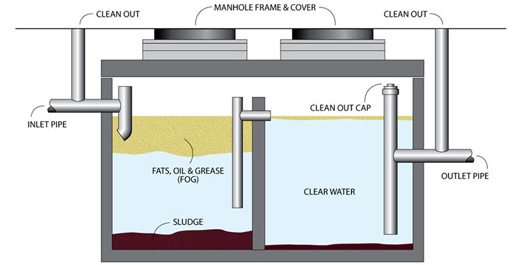Specialist Liquid Waste Removal Melbourne: Fast and Budget Friendly Solutions
Wiki Article
Exactly How Fluid Waste Disposal Works: A Comprehensive Introduction of Strategies and Technologies Used

Introduction of Liquid Waste Kind
The intricacy of liquid waste kinds requires a complete understanding of their attributes and effects for disposal. Liquid waste can broadly be categorized into several kinds, consisting of commercial, metropolitan, agricultural, and harmful waste. Each group displays unique residential properties, calling for particular monitoring techniques to reduce environmental and health threats.
Industrial fluid waste originates from making processes and frequently consists of a variety of impurities, such as heavy steels, solvents, and natural substances. Community liquid waste, primarily making up wastewater from homes and industrial facilities, contains raw material, nutrients, and virus (industrial wastewater treatment). Agricultural liquid waste, consisting of drainage from ranches, may include plant foods, chemicals, and animal waste, posing dangers to water top quality and communities
Unsafe liquid waste is characterized by its poisoning, reactivity, or possible to trigger injury. Understanding these diverse liquid waste kinds is essential for establishing efficient disposal techniques and ensuring compliance with environmental guidelines.
Physical Therapy Techniques

Testing is the initial step, where larger particles and particles are gotten rid of from the fluid waste making use of screens or grates. In sedimentation tanks, larger fragments clear up at the base, creating a sludge layer, while the made clear liquid can be further dealt with.
Purification is one more essential method that entails passing the fluid with porous products, such as sand or membrane layers, to capture smaller sized bits. This step boosts the high quality of the fluid, making it appropriate for subsequent treatment procedures.

Chemical Therapy Strategies
Chemical treatment techniques are necessary for successfully taking care of fluid waste, specifically in attending to dissolved and colloidal contaminants that physical methods might not adequately remove. These strategies make use of numerous chemical agents to counteract, precipitate, or transform hazardous substances into less dangerous forms.One common approach is coagulation and flocculation, where chemicals such as alum or ferric chloride are included to advertise the gathering of suspended fragments. This process boosts sedimentation, permitting for much easier removal of the resulting sludge. Additionally, oxidation processes, using agents like chlorine or ozone, are utilized to break down complex natural substances and pathogens, providing the waste more secure for discharge or additional therapy.
Neutralization is an additional critical strategy, which adjusts the pH of acidic or alkaline waste streams to neutral degrees, avoiding prospective injury to downstream systems and the environment. Additionally, progressed oxidation procedures (AOPs) use mixes of oxidants and ultraviolet light to deteriorate relentless pollutants, achieving a higher degree of treatment performance.
Biological Therapy Processes
Organic treatment processes play a critical role in the management of liquid waste by utilizing bacteria to disintegrate natural issue and lower impurity degrees. These processes can be extensively classified into aerobic and anaerobic therapies, each utilizing specific microbial areas to achieve efficient waste deterioration.Cardio therapy includes using oxygen to facilitate the failure of natural materials by microorganisms. This procedure is frequently applied in turned on sludge systems, where oygenation storage tanks offer a favorable atmosphere for microbial development, causing the oxidation of organic toxins. The resultant biomass can be separated from dealt with effluent via sedimentation.
On the other hand, anaerobic treatment occurs in the lack of oxygen, counting on different microorganisms to damage down natural matter. This technique is specifically advantageous for high-strength waste, as it generates biogas, a renewable resource resource, while decreasing sludge production. Technologies such as anaerobic digesters are often used in commercial and municipal applications.
Both anaerobic and cardio organic therapies not only decrease the environmental influence of liquid waste but likewise help with source recuperation, making them crucial components of lasting waste administration approaches. Their adaptability, efficiency, and efficiency sustain their widespread implementation across numerous markets.
Arising Technologies in Disposal
Cutting-edge techniques to fluid garbage disposal are rapidly advancing, driven by improvements in innovation and an increasing focus on sustainability. Among these emerging modern technologies, membrane bioreactors (MBRs) have actually gotten traction for their capability to integrate biological treatment with membrane filtration, resulting in top notch effluent that can be recycled in numerous applications. MBRs allow smaller footprints and more reliable procedures contrasted to standard systems.Another encouraging development is using anaerobic food digestion incorporated with nutrient recuperation modern technologies, which not only deals with fluid waste yet also produces biogas and recoups useful nutrients like nitrogen and phosphorus. This twin advantage boosts resource performance liquid waste disposal melbourne and reduces environmental effect.
Furthermore, advanced oxidation processes (AOPs) are being adopted for the degradation of complex organic contaminants. These methods utilize powerful oxidants and drivers to break down contaminants at the molecular level, offering a very reliable option for challenging waste streams.
Furthermore, the integration of synthetic intelligence and equipment understanding in waste monitoring systems is enhancing operational performance and anticipating upkeep, causing minimized expenses and boosted ecological conformity. These innovations reflect a considerable shift in the direction of more lasting and efficient liquid waste disposal methods.
Conclusion
In final thought, efficient fluid waste disposal necessitates a detailed understanding of different strategies and modern technologies. By constantly advancing these approaches, it ends up being possible to deal with the expanding difficulties associated with fluid waste, eventually contributing to environmental defense and resource recovery.Fluid waste disposal is a crucial facet of ecological management, requiring a thorough understanding of different methods and modern technologies customized to different waste kinds. Fluid waste can extensively be categorized right into several kinds, including commercial, local, farming, and harmful waste. Agricultural liquid waste, including runoff from ranches, may contain fertilizers, chemicals, and pet waste, presenting threats to water high quality and ecosystems.
Different physical therapy methods play an essential role in handling fluid waste effectively - industrial wastewater treatment.In final thought, reliable liquid waste disposal requires a thorough understanding of different methods and modern technologies
Report this wiki page